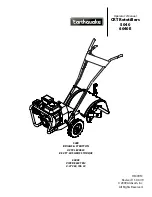
Pub. # OM20-MSP3-3D
6-7
Coulter Electrode Functions-
Each coulter electrode on the implement is part of a pair, and each pair has a distinct function.
MSP-3
a) Coulters 1 & 6 are the 0-
3’ EC receptors. If you are seeing problems only with the “0-3”
readings, focus on testing continuity on these two coulter-electrodes.
b) Coulters 3 & 4 are the 0-
1’ EC receptors. If you are seeing problems only with the “0-1”
readings, focus on testing continuity on these two coulter electrodes.
c) Coulters 2 & 5 are coulters that inject the voltage into the soil. If you are getting no (or
intermittent) readings on all three arrays -- continuity to one of these two coulter-electrodes is
likely the cause.
MSP3-3D
a) Coulters 1 & 8 are the 2-
3’ EC receptors. If you are seeing problems only with the “2-3”
readings, focus on testing continuity on these two coulter-electrodes.
b) Coulters 2 & 7 are the 1-
2’ EC receptors. If you are seeing problems only with the “1-2”
readings, focus on testing continuity on these two coulter electrodes.
c) Coulters 3 & 6 are coulters that inject the voltage into the soil. If you are getting no (or
intermittent) readings on all three arrays -- continuity to one of these two coulter-electrodes is
likely the cause.
d) Coulters 4 & 5 are the 0-
1’ receptors. Focus on this pair if you see problems in the “0-1”
reading.
If the continuity ohm test indicates a problem on a channel, you will need to determine where the
interruption is located. Listed below are detailed instructions on how to determine exactly where a
continuity or isolation problem is located:
A. Testing Cable and Wiring continuity:
1. Once a high resistance reading on a channel is confirmed, determine whether the problem
is in the wiring or in the coulter-electrode. To test all cable and wiring, place one ohmmeter
lead in the Test Box terminal pin for that channel and the other on the corresponding coulter
wire terminal bolt. Grasp sure-seal connector and move back and forth during this test
–
vibration from rough fields can weaken the contacts on the sure seal, causing breaks in
continuity during operation that might not show up in a static test. Repeat process on all
coulter-electrodes.
2. If you see <2 ohms on all, test the coulter electrodes as explained below.
3. If you see a > 2ohms reading on any channel, separate Weatherpack connector and insert
one ohmmeter lead in the end of wiring harness and the other lead in the corresponding
terminal on the Test Box. If reading is < 2 ohms at that point, the problem is not with the
wiring harness or signal cable extension. It is most likely in the terminal connector wire.
Check resistance in it by placing one ohmmeter lead on the coulter wire terminal bolt and
the other lead in the end of the terminal wire socket. Replace connector wire (PN 14226) as
necessary.
















































